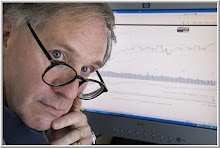
3/21/2025 - In the previous post, we looked at a psychological perspective about why traders might give back profits after a period of successful trading. Now let's look at more logical, structural reasons for these givebacks.
What's important to realize is that the market's largest participants trade thematically. That is, they look for patterns of strength and weakness across different stocks, different sectors, different equity markets, and different asset classes--and they look for reasons that explain these themes. When the themes change for economic or geopolitical reasons, the market that you are trading can shift greatly in its patterns of volatility/volume and correlation to other instruments. If you fail to recognize the theme driving the change, you're likely to lose money and not realize why.
Themes have changed in 2025. Look at how the US dollar has been trading against the Japanese Yen, the Euro, and the British Pound. Look at the the US stock market (SPX) has been trading relative to the European markets (VGK) and the rest of the world (EFA). Look at how interest rates have been coming down, but not as much in the junk bond market (JNK). Look at how volatility (VIX) has expanded.
The dominant theme has been anticipation of economic weakness in the U.S., resulting in a flight from many U.S. assets. If we only look at the charts of what we are trading, we miss the broader patterns that reflect what large investors are doing. By noticing the patterns across markets, we can create tailwinds for trading our markets.
3/20/2025 - I received an excellent question from a reader:
"I keep going through the same problems. I make money for a while and then go on a losing streak and give it all back. How can I change this?"
Brett's response: Going through unusual ups and downs in performance can occur for psychological reasons, and it can occur for logical reasons. The key to figuring out what to do is to first identify the problem.
You'll know that the problem is psychological if you review your trading in detail and see if your trading patterns change following winning periods. Do you trade larger after you've made some money? Do you trade more often? Do you expand what you've traded? Many times, out of confidence becoming overconfidence, traders will stop doing what made them money and lose a good amount of money.
The key is recognizing that making money puts you at risk!! This is when you can get sloppy; this is when you can overtrade and oversize. After you've made money, you want to trade extra carefully. You want to ask yourself, "Would I be making this trade in this way if I had just been losing money?" By putting yourself in the mindset of risk management, you prevent yourself from becoming overconfident and impulsive. After a winning period, double down on sound trading process, knowing how easy it is to ease up on your rules.
And what if your losing money is not due to a change in mindset, but a change in markets...how can you adapt to that? I'll tackle that one in the next post!
3/19/2025 - This is an additional question from the group coaching session that addresses a situation faced by many traders in the recent volatile markets:
"Recently I am struggling to focus on process because I had quite a drawdown, and it's hard to push thoughts about making money now away. Any advice?"
Brett's response: Every drawdown/loss should be planned. You should always know how much money you're willing to lose on a trade, how much you're willing to lose each day, and how much you're willing to lose each week and month. Knowing your loss limits in advance helps in two ways: 1) You can be psychologically prepared for inevitable drawdowns and still maintain a focused mindset, because no drawdown feels like "quite a drawdown"; and 2) You always give yourself room to come back. As I mention in my books, traders I worked with in Chicago (who were very short-term) had a separate loss limit for the morning trading and for the afternoon. They always gave themselves an opportunity to come back on the day and, on losing days, they could always come back on the week. Any planned activity becomes familiar and cannot trigger us. Mentally rehearsing the downside and being at peace with your loss limits prevents frustration from ever impacting our trading.
If you've taken a large, unplanned hit, returning to trading in simulation mode (take P/L off the table temporarily), regaining your rhythm and focus, and then sizing up gradually allows you to recover. If you can't focus on the market, it's time to work on your focus.
3/18/2025 - Here's another question that arose during the coaching session:
"What are the skills you recommend to handle our triggers?"
Brett's response: Notice that the trader recognizes something very important. Our problems are not just negative trading behaviors (such as going on tilt), but whatever triggers those negative behaviors. If we can control our triggers, we can prevent problems like overtrading from occurring in the first place.
The very first step is recognizing the trigger as it is occurring. For instance, we might wait for a perfect entry on a trade only to see the market make its move without us. That triggers frustration, and the frustration can lead to chasing the trade and executing at a really poor level. We can only identify our trigger patterns by studying our preventable losing trades and dissecting how they occurred. In the above case, what sets up the poor trade is not just the frustration, but the perfectionism that precedes it. Very often, our excessive expectations set up our excessive frustrations.
By working on our thinking patterns as we're trading, we can ensure that we're going into trading with realistic expectations that won't frustrate us. For instance, my first entry on a trade is always small and at a good level, not necessarily a great level. "Good enough is good enough" is the mindset I rehearse. I have favorable reward to risk and that's good enough for an entry. If the position moves against me, but not to my stop, I'm prepared to add another clip at a more favorable level. If the position moves immediately to my target, I've made a decent profit.
Note that these kinds of thinking patterns can be mentally rehearsed before the market open and during trading reviews. The best way to handle our triggers is to identify what sets them off and create new patterns of psychological win/win.
===
3/16/2025 - In this series of posts, I will address questions that traders posed during my recent group coaching session with Agnieszka Wood and Alex Serzhanovitch. If you have trading questions you would like me to address, please feel free to reach out to me via Twitter/X.The first question is: "Given that markets constantly change, how can traders develop the psychological flexibility needed to adapt their strategies without falling into emotional overreaction or hesitation?"
Brett's response: This is a great example of a situation where improvements in trading process can create improvements in our trading psychology. Basically, what active traders need is real time information that tells them that their market is changing. The professional traders I work with at hedge funds monitor real time price change, of course, but also real time market volume and volatility and real time correlations. Very often, shifts in volume/volatility and correlations precede shifts in trading direction. A simple example would be a stock that moves out of a range to the upside but then stalls on low volume. If this was a valid breakout, one might expect short-term participants to take advantage of the move, resulting in increased volume and volatility. One might also expect that, if the stock's upside breakout was valid, it would be accompanied by similar moves in other stocks in the same sector and perhaps by similar moves in the overall market. By monitoring this real time behavior, traders can become highly flexible in jumping aboard moves or fading them. Once the market changes are perceived and understood in a broader context, the trader can quickly adapt.
Recently, the market made an intraday high but many sectors (including small caps) lagged significantly. This was very helpful information in fading the strength. Practicing trading with small size while making these observations and adaptations provides the experience that leads to confidence. How the market moves is just as important as the moves it makes.















